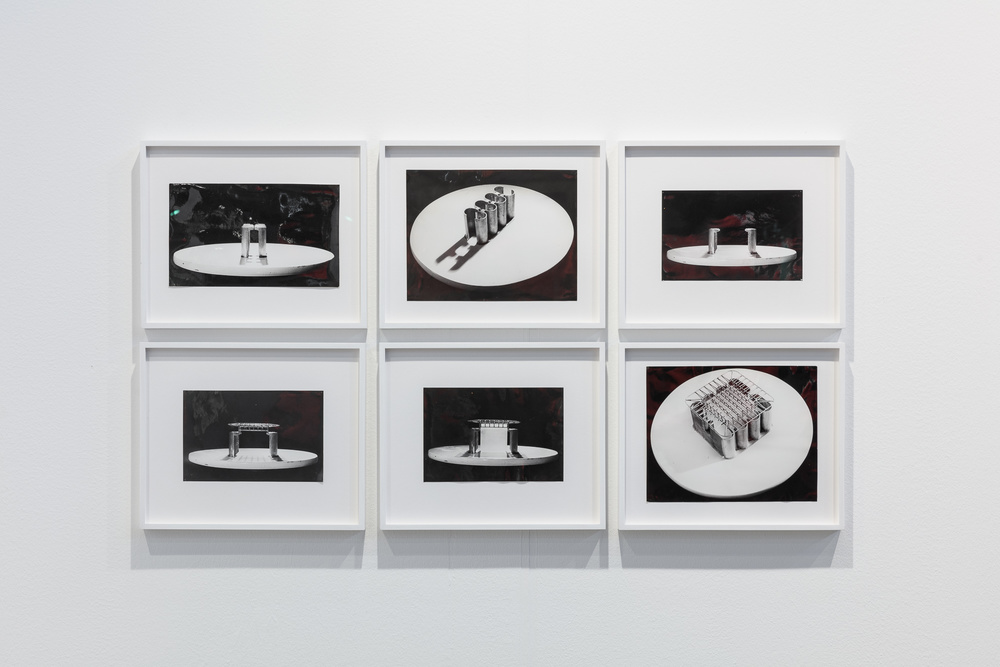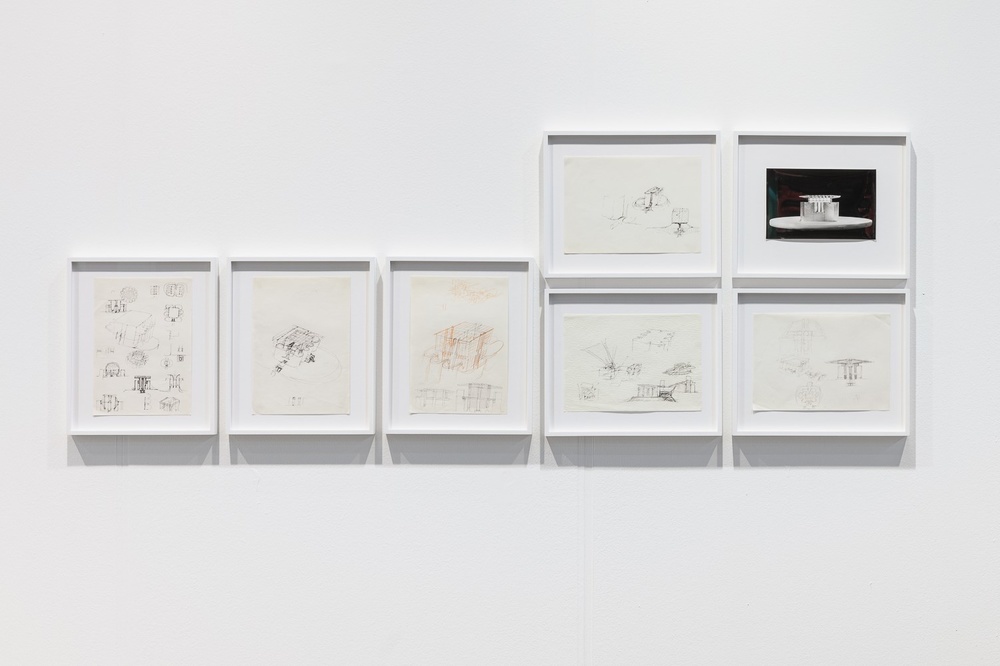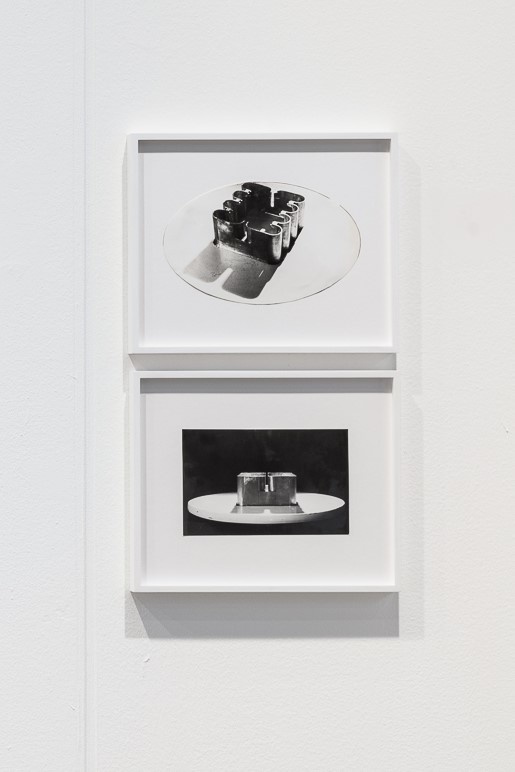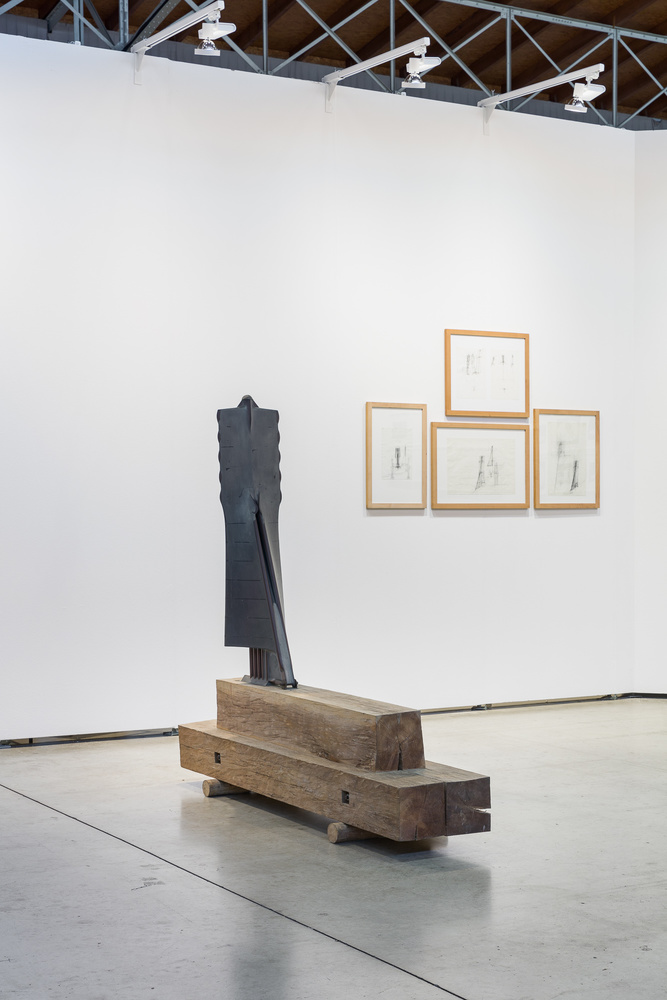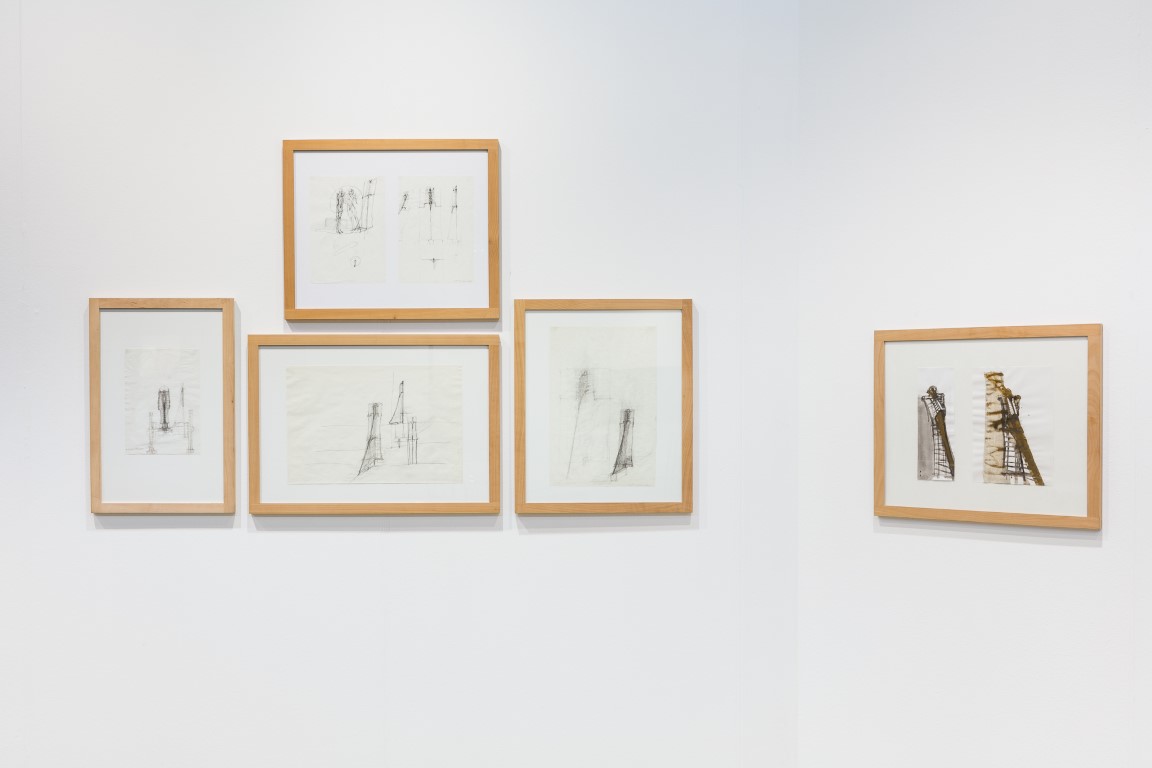Galerie Elisabeth & Klaus Thoman
Walter Pichler
With his equally radical and utopian sketches of architecture and design, Walter Pichler is one of the most idiosyncratic artistic personalities of his time.
The early sculptures, the ‚radical architectures‘ of 1962-1964, the iconic ‚prototypes‘ 1966-1969 and the sculptures in their individual buildings in St. Martin from the 1970s onwards, as well as the realized or conceived buildings from the mid-1990s onwards, consolidate his influence to this day.
‚Frau aus Metall‘ is an important work of Pichler’s. He started it very early – it was one of the first he began at St Martin and developed until 1990. It was originally intended for the vestibule of the ‚Türmchen‘ (turret) for the women. As it is often the case, Pichler developed various versions of his sculptures and their buildings in terms of drawings, and here he finally decided on the free positioning of the ‘Frau aus Metall’.
This makes the ‘Frau aus Metall’ one of the very few ‘solitary’ sculptures that does not have its own space.
‚Entwurf für eine Kirche‘ is an early architectural design that can certainly be counted among the ‚radical architectures‘. The model no longer exists, only the photos and drawings. The church can also be understood as an original design for space. This can be illustrated on one of the photos. Shown is a white cube in the model, that creates a kind of archetype of space.
The sculpture accompanied by those groups of photographs and drawings, is showing Pichler’s graphic imagery in its highly differentiated variety over the decades. They testify to Pichler’s incessant artistic demand to break routine and always start from scratch and differently, to draw the thinking and to think through the drawing.
Biography
Walter Pichler was born in Deutschnofen, South Tyrol, in 1936. He studied at the school of arts and crafts in Innsbruck and
then the University of Applied Arts in Vienna until 1959. His first exhibition Architektur, together with Hans Hollein, at the
Galerie nächst St. Stephan, in 1963, was one of the most influential Austrian contemporary art exhibitions of the post-war
years. In 1967, MOMA New York presented the Visionary Architects Raimund Abraham, Hans Hollein, and Walter Pichler.
In 1968, Arnold Bode invited him to the Documenta IV in Kassel. At the beginning of the seventies, Pichler acquired a little
farmstead in St. Martin an der Raab in Southern Burgenland, which served him both as workshop and home, but also as an
exhibition space for his sculptures. In 1972, he exhibited at Hamburger Kunsthalle, and with Projects paid another visit to
MoMA New York in 1975. Under Commissioner Hans Hollein, Pichler also exhibited at the Venice Biennial in 1982. In
1984, Pichler was the first recipient of the Tyrolean State Prize for Art, which he immediately passed on to Max Peintner. In
1985, he was awarded the Grand Austrian State Prize for Visual Art. Walter Pichler died in Vienna on July 16, 2012. The
Gallery Elisabeth & Klaus Thoman and Walter Pichler are connected by a long period of joint exhibition activity, which
continues intensively even after his death. The artist’s works are represented in many international collections, including The
Museum for Modern Art, New York, Centre Pompidou, Paris or the Museum moderner Kunst Stiftung Ludwig, Wien.
Galerie Elisabeth & Klaus Thoman
Founded in 1977 in Innsbruck, Galerie Elisabeth & Klaus Thoman has been working with important and internationally renowned contemporary artists from Austria, including Bruno Gironcoli, Hermann Nitsch, Walter Pichler, Arnulf Rainer and Franz West. In the 80s the gallery started working with a younger generation of painters – Siegfried Anzinger, Herbert Brandl, Erwin Bohatsch and Gunter Damisch – that were just leaving the academies, later known as “Neue Wilde”. Artist from different media and the neighbouring countries joined the gallery in the 90s and early 2000s: Éva Bodnár, Maria Brunner, Thomas Feuerstein, Michael Kienzer, Florin Kompatscher and Peter Sandbichler.
The gallery profile is continuously complemented with significant international positions, always taken in a cultural context: John M Armleder, Günther Förg, Jürgen Klauke and Tal R; as well as our latest international collaborations: Mai-Thu Perret and Johannes Wohnseifer. The focus remains to work with artists long-term and to accompany them through their career. In 2011, the gallery opened a large-scale dependance in Vienna’s first district. While Elisabeth and Klaus Thoman have been operating as the gallerists for already 40 years, in 2020 a younger generation of directors joined their team, consisting of Maximilian Thoman and Eva Oberhofer. They are now taking care of the space in Vienna as well as continuously adding new positions to the gallery’s artist list, like Julia Haugeneder and Johannes Kofler.
Furthermore a dialogue with emerging artists was founded with the projectspace tart.vienna, that regularly hosts exhibitions for external artists in the gallery’s Seitengalerie.

+4315120840
Maximilian Thoman
06643508847
Walter Pichler
With his equally radical and utopian sketches of architecture and design, Walter Pichler is one of the most idiosyncratic artistic personalities of his time.
The early sculptures, the ‚radical architectures‘ of 1962-1964, the iconic ‚prototypes‘ 1966-1969 and the sculptures in their individual buildings in St. Martin from the 1970s onwards, as well as the realized or conceived buildings from the mid-1990s onwards, consolidate his influence to this day.
‚Frau aus Metall‘ is an important work of Pichler’s. He started it very early – it was one of the first he began at St Martin and developed until 1990. It was originally intended for the vestibule of the ‚Türmchen‘ (turret) for the women. As it is often the case, Pichler developed various versions of his sculptures and their buildings in terms of drawings, and here he finally decided on the free positioning of the ‘Frau aus Metall’.
This makes the ‘Frau aus Metall’ one of the very few ‘solitary’ sculptures that does not have its own space.
‚Entwurf für eine Kirche‘ is an early architectural design that can certainly be counted among the ‚radical architectures‘. The model no longer exists, only the photos and drawings. The church can also be understood as an original design for space. This can be illustrated on one of the photos. Shown is a white cube in the model, that creates a kind of archetype of space.
The sculpture accompanied by those groups of photographs and drawings, is showing Pichler’s graphic imagery in its highly differentiated variety over the decades. They testify to Pichler’s incessant artistic demand to break routine and always start from scratch and differently, to draw the thinking and to think through the drawing.
Biography
Walter Pichler was born in Deutschnofen, South Tyrol, in 1936. He studied at the school of arts and crafts in Innsbruck and
then the University of Applied Arts in Vienna until 1959. His first exhibition Architektur, together with Hans Hollein, at the
Galerie nächst St. Stephan, in 1963, was one of the most influential Austrian contemporary art exhibitions of the post-war
years. In 1967, MOMA New York presented the Visionary Architects Raimund Abraham, Hans Hollein, and Walter Pichler.
In 1968, Arnold Bode invited him to the Documenta IV in Kassel. At the beginning of the seventies, Pichler acquired a little
farmstead in St. Martin an der Raab in Southern Burgenland, which served him both as workshop and home, but also as an
exhibition space for his sculptures. In 1972, he exhibited at Hamburger Kunsthalle, and with Projects paid another visit to
MoMA New York in 1975. Under Commissioner Hans Hollein, Pichler also exhibited at the Venice Biennial in 1982. In
1984, Pichler was the first recipient of the Tyrolean State Prize for Art, which he immediately passed on to Max Peintner. In
1985, he was awarded the Grand Austrian State Prize for Visual Art. Walter Pichler died in Vienna on July 16, 2012. The
Gallery Elisabeth & Klaus Thoman and Walter Pichler are connected by a long period of joint exhibition activity, which
continues intensively even after his death. The artist’s works are represented in many international collections, including The
Museum for Modern Art, New York, Centre Pompidou, Paris or the Museum moderner Kunst Stiftung Ludwig, Wien.
Galerie Elisabeth & Klaus Thoman
Founded in 1977 in Innsbruck, Galerie Elisabeth & Klaus Thoman has been working with important and internationally renowned contemporary artists from Austria, including Bruno Gironcoli, Hermann Nitsch, Walter Pichler, Arnulf Rainer and Franz West. In the 80s the gallery started working with a younger generation of painters – Siegfried Anzinger, Herbert Brandl, Erwin Bohatsch and Gunter Damisch – that were just leaving the academies, later known as “Neue Wilde”. Artist from different media and the neighbouring countries joined the gallery in the 90s and early 2000s: Éva Bodnár, Maria Brunner, Thomas Feuerstein, Michael Kienzer, Florin Kompatscher and Peter Sandbichler.
The gallery profile is continuously complemented with significant international positions, always taken in a cultural context: John M Armleder, Günther Förg, Jürgen Klauke and Tal R; as well as our latest international collaborations: Mai-Thu Perret and Johannes Wohnseifer. The focus remains to work with artists long-term and to accompany them through their career. In 2011, the gallery opened a large-scale dependance in Vienna’s first district. While Elisabeth and Klaus Thoman have been operating as the gallerists for already 40 years, in 2020 a younger generation of directors joined their team, consisting of Maximilian Thoman and Eva Oberhofer. They are now taking care of the space in Vienna as well as continuously adding new positions to the gallery’s artist list, like Julia Haugeneder and Johannes Kofler.
Furthermore a dialogue with emerging artists was founded with the projectspace tart.vienna, that regularly hosts exhibitions for external artists in the gallery’s Seitengalerie.
ABOUT Walter Pichler


